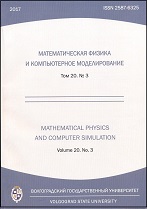|
|
Vestnik Volgogradskogo gosudarstvennogo universiteta. Seriya 1. Mathematica. Physica, 2017, Issue 2(39), Pages 39–55
(Mi vvgum171)
|
 |
|
 |
This article is cited in 1 scientific paper (total in 1 paper)
Computer modelling
Universal software for solving multidimensional variational problems
E. G. Grigor'eva, V. A. Klyachin, A. A. Klyachin
Volgograd State University
Abstract:
The article considers the problem of numerical calculation of the piecewise linear surfaces $ M $, wich is extremal for the functional type
$$
F(M)=\int\limits_{M}\left(\Phi(\xi)+\alpha(x)\right)dS.
$$
To solve this problem, we obtain formulas for the calculation of the gradient of the functional in the space of polygonal surfaces $M$ as a set $P$ of its vertices
$$
\left(\frac{\partial \tilde{F}}{\partial h}(P)\right)^i=\frac{1}{2}\langle\sum_{j=1}^k\left(\nabla \Phi(2\xi_j|T_j|)\right)\times l_j,h\rangle+\frac{1}{2}\langle\sum_{j=1}^k\alpha(p^*_j)\xi_j\times l_j,h\rangle\,+
$$
$$
+\,\frac{1}{3}\langle\sum_{j=1}^k\nabla \alpha(p^*_j)|T_j|,h\rangle.
$$
For the organization of calculations on the basis of these formulas, we construct a system of classes in the Python programming language. The system is organized as a class package wich is integrated in the simulation environment 3D Blender. This solution allows the user for the program Blender in interactive mode to perform the desired surface topology modeling, to set the boundary conditions and to visualize the results of calculation.
In this paper, we present our implementation of a variational method based on approximation of piecewise-linear functions and surfaces. We proceed from the idea of creating a universal software system, most of which does not depend on the use of triangulation, integral functional, computational domain and boundary conditions. In this article we present the structure of input data, which is stored in the boundary conditions, and the vertices and the triangles of the triangulation and the description of the main program procedures. We are considering a number of illustrative examples of solving boundary value problems of mathematical physics.
Keywords:
extremal surface, piecewise linear approximation, triangulation, NumPy package, boundary problem.
Citation:
E. G. Grigor'eva, V. A. Klyachin, A. A. Klyachin, “Universal software for solving multidimensional variational problems”, Vestnik Volgogradskogo gosudarstvennogo universiteta. Seriya 1. Mathematica. Physica, 2017, no. 2(39), 39–55
Linking options:
https://www.mathnet.ru/eng/vvgum171 https://www.mathnet.ru/eng/vvgum/y2017/i2/p39
|

| Statistics & downloads: |
| Abstract page: | 266 | | Full-text PDF : | 85 | | References: | 60 |
|




 Contact us:
Contact us: Terms of Use
Terms of Use
 Registration to the website
Registration to the website Logotypes
Logotypes








 Citation in format
Citation in format 
